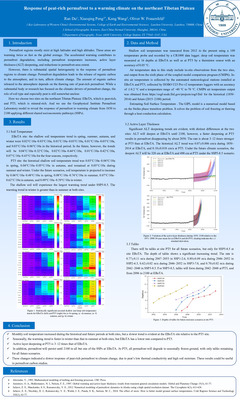Response of peat-rich permafrost to a warming climate on the northeast Tibetan Plateau
编号:2635
稿件编号:903 访问权限:仅限参会人
更新:2021-07-03 10:37:32
浏览:1152次
张贴报告
摘要
Permafrost degradation leads to the release of organic carbon to the atmosphere, and in turn, affects climate change. The amount of organic carbon released to the atmosphere depends on the thawing rate of peat-rich permafrost. However, the exact mechanism of peat-rich permafrost thawing is still unclear. Here we choose two sites on the northeast Tibetan Plateau: EBoTA, which is peat-rich, and PT5, which is mineral-rich. We use the Geophysical Institute Permafrost Laboratory model to reveal the response of permafrost to warming climate from 1850 to 2100 applying different shared socioeconomic pathways (SSPs). Monthly soil temperature increased during the historical and future periods at both sites, but a slower trend is evident at the EBoTA site relative to the PT5 site. Seasonally, the warming trend is faster in winter than that in summer at both sites. Active layer deepening at PT5 is 3–12 times that of EBoTA. In addition, permafrost will persist until 2100 in all but one of the SSPs at EBoTA. At PT5, all permafrost will degrade to seasonally frozen ground, with only taliks remaining for all future scenarios. These changes indicated a slower response of peat-rich permafrost to climate change, due to peat’s low thermal conductivity and high soil moisture. These results could be useful in permafrost carbon studies.
关键字
peat, GIPL model, SSPs, northeast Tibetan Plateau


发表评论